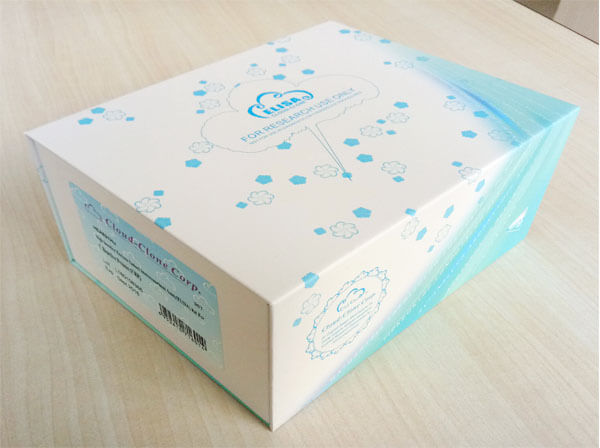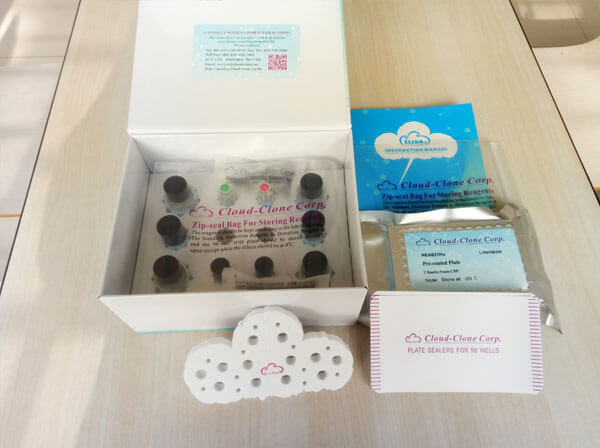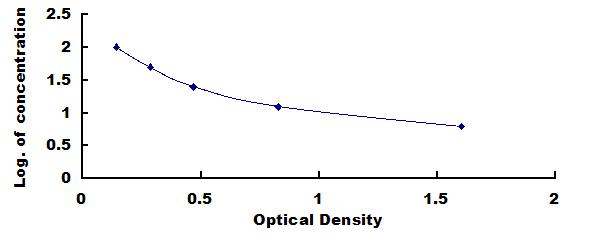High Sensitive ELISA Kit for Fibroblast Growth Factor 15 (FGF15) 

- UOM
- FOB US$ 610.00 US$ 871.00 US$ 3,920.00 US$ 7,404.00 US$ 60,970.00
- Quantity
Overview
Properties
- Product No.HEL154Mu
- Organism SpeciesMus musculus (Mouse) Same name, Different species.
- ApplicationsEnzyme-linked immunosorbent assay for Antigen Detection.
Research use only - DownloadInstruction Manual
- CategoryHuman gene deletion
Sign into your account
Share a new citation as an author
Upload your experimental result
Review

Contact us
Please fill in the blank.
Recovery
Matrices listed below were spiked with certain level of recombinant High Sensitive Fibroblast Growth Factor 15 (FGF15) and the recovery rates were calculated by comparing the measured value to the expected amount of High Sensitive Fibroblast Growth Factor 15 (FGF15) in samples.
| Matrix | Recovery range (%) | Average(%) |
| serum(n=5) | 80-103 | 88 |
| EDTA plasma(n=5) | 90-102 | 95 |
| heparin plasma(n=5) | 87-103 | 91 |
Precision
Intra-assay Precision (Precision within an assay): 3 samples with low, middle and high level High Sensitive Fibroblast Growth Factor 15 (FGF15) were tested 20 times on one plate, respectively.
Inter-assay Precision (Precision between assays): 3 samples with low, middle and high level High Sensitive Fibroblast Growth Factor 15 (FGF15) were tested on 3 different plates, 8 replicates in each plate.
CV(%) = SD/meanX100
Intra-Assay: CV<10%
Inter-Assay: CV<12%
Linearity
The linearity of the kit was assayed by testing samples spiked with appropriate concentration of High Sensitive Fibroblast Growth Factor 15 (FGF15) and their serial dilutions. The results were demonstrated by the percentage of calculated concentration to the expected.
| Sample | 1:2 | 1:4 | 1:8 | 1:16 |
| serum(n=5) | 82-98% | 80-99% | 78-97% | 87-102% |
| EDTA plasma(n=5) | 91-101% | 87-104% | 96-105% | 81-93% |
| heparin plasma(n=5) | 85-98% | 82-98% | 94-102% | 92-99% |
Stability
The stability of kit is determined by the loss rate of activity. The loss rate of this kit is less than 5% within the expiration date under appropriate storage condition.
To minimize extra influence on the performance, operation procedures and lab conditions, especially room temperature, air humidity, incubator temperature should be strictly controlled. It is also strongly suggested that the whole assay is performed by the same operator from the beginning to the end.
Reagents and materials provided
| Reagents | Quantity | Reagents | Quantity |
| Pre-coated, ready to use 96-well strip plate | 1 | Plate sealer for 96 wells | 4 |
| Standard | 2 | Standard Diluent | 1×20mL |
| Detection Reagent A | 1 | Assay Diluent A | 1×12mL |
| Detection Reagent B | 1×120µL | Assay Diluent B | 1×12mL |
| Reagent Diluent | 1×300µL | Stop Solution | 1×6mL |
| TMB Substrate | 1×9mL | Instruction manual | 1 |
| Wash Buffer (30 × concentrate) | 1×20mL |
Assay procedure summary
1. Prepare all reagents, samples and standards;
2. Add 50µL standard or sample to each well.
And then add 50µL prepared Detection Reagent A immediately.
Shake and mix. Incubate 1 hour at 37°C;
3. Aspirate and wash 3 times;
4. Add 100µL prepared Detection Reagent B. Incubate 30 minutes at 37°C;
5. Aspirate and wash 5 times;
6. Add 90µL Substrate Solution. Incubate 10-20 minutes at 37°C;
7. Add 50µL Stop Solution. Read at 450 nm immediately.

Test principle
This assay employs the competitive inhibition enzyme immunoassay technique. A monoclonal antibody specific to High Sensitive Fibroblast Growth Factor 15 (FGF15) has been pre-coated onto a microplate. A competitive inhibition reaction is launched between biotin labeled High Sensitive Fibroblast Growth Factor 15 (FGF15) and unlabeled High Sensitive Fibroblast Growth Factor 15 (FGF15) (Standards or samples) with the pre-coated antibody specific to High Sensitive Fibroblast Growth Factor 15 (FGF15). After incubation the unbound conjugate is washed off. Next, avidin conjugated to Horseradish Peroxidase (HRP) is added to each microplate well and incubated. The amount of bound HRP conjugate is reverse proportional to the concentration of High Sensitive Fibroblast Growth Factor 15 (FGF15) in the sample. After addition of the substrate solution, the intensity of color developed is reverse proportional to the concentration of High Sensitive Fibroblast Growth Factor 15 (FGF15) in the sample.
Giveaways
Increment services
Citations
- Naringenin Prevents Obesity, Hepatic Steatosis, and Glucose Intolerance in Male Mice Independent of Fibroblast Growth Factor 21PubMed: 25774553
- Alterations in Enterohepatic Fgf15 Signaling and Changes in Bile Acid Composition Depend on Localization of Murine Intestinal Inflammationpubmed:27580383
- Commensal bacteria at the crossroad between cholesterol homeostasis and chronic inflammation in atherosclerosis.pubmed:28130274
- The relationship between bile acid concentration, glucagon-like-peptide 1, fibroblast growth factor 15 and bile acid receptors in rats during progression of glucose intolerance10.1186/s12902-017-0211-5
- The ileal FGF15/19 to hepatic FGFR4 axis regulates liver regeneration after partial hepatectomy in micePubmed:29468415
- FGF15 Activates Hippo Signaling to Suppress Bile Acid Metabolism and Liver TumorigenesisPubmed: 30745141
- Interactions between the gravitostat and the fibroblast growth factor system for the regulation of body weight
- Lactoferrin promotes bile acid metabolism and reduces hepatic cholesterol deposition by inhibiting the farnesoid X receptor (FXR)-mediated enterohepatic axisPubmed: 31626262
- Gut microbiota from coronary artery disease patients contributes to vascular dysfunction in mice by regulating bile acid metabolism and immune activationPubmed: 33036625
- Si-Wu-Tang ameliorates fibrotic liver injury via modulating intestinal microbiota and bile acid homeostasis34736501
- Dynamics of the gut-liver axis in rats with varying fibrosis severityPubmed:35637968















